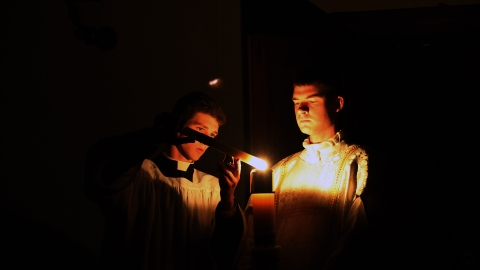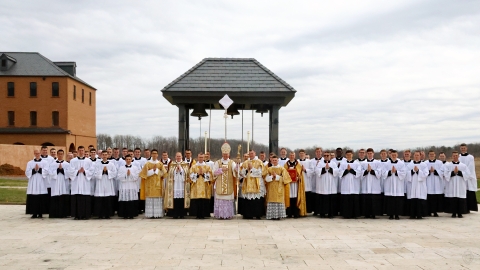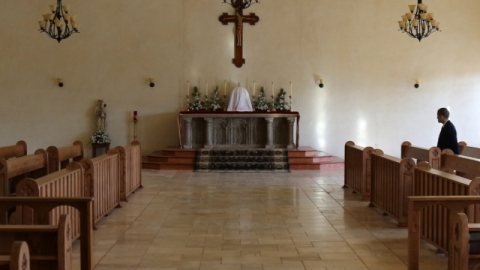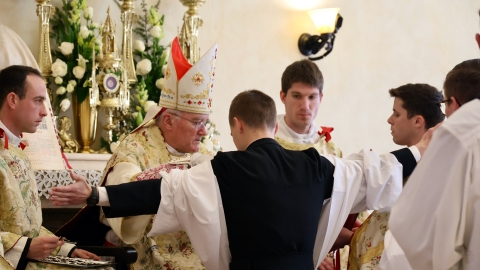Easter greetings!

From the great work of Dom Prosper Guéranger, The Liturgical Year, we offer you a partion of his reflection on Easter Sunday morning and also share with you pictures of the liturgies of Palm Sunday and the Triduum at the Seminary.
The night between Saturday and Sunday has well nigh run its course, and the day-dawn is appearing. The Mother of sorrows is waiting, in courageous hope and patience, for the blissful moment of her Jesus’ return. Magdalene and the other holy women have spent the night in watching, and are preparing to start for the sepulchre. In limbo, the Soul of our crucified Lord is about to give the glad word of departure to the myriads of the long-imprisoned holy souls, who cluster round Him in adoring love. Death is still holding his silent sway over the sepulchre, where rests the Body of Jesus. Since the day when he gained his first victim, Abel, he has swept off Countless generations; but never has he held in his grasp a prey so noble as this that now lies in the tomb near Calvary. Never has the terrible sentence of God, pronounced against our first parents, received such a fulfilment as this; but, never has death received such a defeat as the one that is now preparing. It is true, the power of God has, at times, brought back the dead to life: the son of the widow of Naim, and Lazarus, were reclaimed from the bondage of this tyrant death; but he regained his sway over them all. But his Victim of Calvary is to conquer him for ever, for this is He of whom it is written in the prophecy: ‘O death! I will be thy death!’ [Osee, xiii, 14]. Yet a few brief moments and the battle will be begun, and life shall vanquish death.
As divine justice could not allow the Body that was united to the Word to see corruption, and there wait, like ours must, for the Archangel’s word to ‘rise and come to judgement,’ so neither could it permit the dominion of death to be long over such a Victim. Jesus had said to the Jews: ‘A wicked generation seeketh a sign; and a sign shall not be given it, but that of Jonas the prophet.’ [St. Matth. xii, 39]. Three days in the tomb, - the afternoon and night of Friday, the whole of Saturday, and a few hours of the Sunday, - yes, these are enough: enough to satisfy divine justice; enough to certify the death of the Crucified, and make His triumph glorious; enough to complete the martyrdom of that most loving of mothers, the Queen of sorrows.
‘No man taketh away my life from Me: I lay it down of Myself: I have power to lay it down, and I have power to take it up again.’ [St. John, x, 18]. Thus spoke our Redeemer to the Jews before His Passion: now is the hour for the fulfilment of His words, and death shall feel their whole force. The day of light, Sunday, has begun, and its early dawn is struggling with the gloom. The Soul of Jesus immediately darts from the prison of limbo, followed by the whole multitude of the holy souls that are around Him. In the twinkling of an eye, it reaches and enters the sepulchre, and reunites itself with that Body, which, three days before, it had quitted amidst an agony of suffering. The sacred Body returns to life, raises itself up, and throws aside the winding-sheet, the spices, and the bands. The bruises have disappeared, the Blood has been brought back to the veins; and from these limbs that bad been torn by the scourging, from this head that had been mangled by the thorns, from these hands and feet that had been pierced with nails, there darts forth a dazzling light that fills the cave. The holy Angels had clustered round the stable and adored the Babe of Bethlehem; they are now around the sepulchre, adoring the conqueror of death. They take the shrouds, and reverently folding them up, place them on the slab, whereon the Body had been laid by Joseph and Nicodemus.
But Jesus is not to tarry in the gloomy sepulchre. Quicker than a ray of light through a crystal, He passes through the stone that closes the entrance of the cave. Pilate had ordered his seal to be put upon this stone, and a guard of soldiers is there to see that no one touches it. Untouched it is, and unmoved; and yet Jesus is free! Thus, as the holy Fathers unanimously teach us, was it at His birth: He appeared to the gaze of Mary, without having offered the slightest violence to her maternal womb. The birth and the resurrection, the commencement and the end of Jesus’ mission, these two mysteries bear on them the seal of resemblance: in the first, it is a Virgin Mother; in the last, it is a sealed tomb giving forth its captive God.





